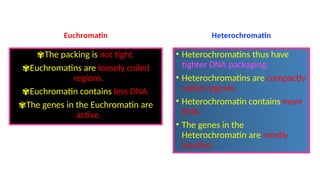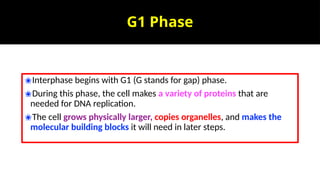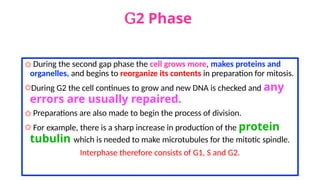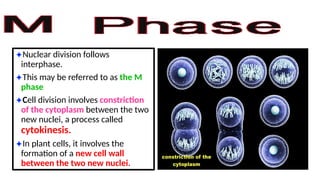Mitosis cell cycle biology IGCSE 0610 revision
- 1. When body cells reach a certain size they divide into two. Nuclear division occurs first, followed by division of the cytoplasm. The mitotic cell cycle of eukaryotes involves DNA replication followed by nuclear division. This ensures the genetic uniformity of all daughter cells. © Mr. Suman Neerukonda
- 3. © Mr. Suman Neerukonda
- 4. ✭During growth of multicellular organisms, the nucleus divides before the cell divides so that each new cell contains an identical nucleus. ✭With a partner, discuss briefly why this is important. Then carry out the following exercise. ✭Make a list of four structural features of the nucleus of eukaryotes. For each feature, outline its function (or an example of its function). © Mr. Suman Neerukonda
- 7. Colored scanning electron micrographs of human chromosomes showing the location of telomeres at the ends of the chromosomes. Chromatids and centromeres are also clearly visible. Telomeres contain short repeated sequences of DNA. As cells replicate and age, the telomeres gradually get shorter. Stem cells are an exception. © Mr. Suman Neerukonda
- 8. Telomeres And Enzyme Telomerase Telomeres are protective sequences of nucleotides found at the ends of chromosomes, which become shorter every time a cell divides. A gradual degeneration of the organism occurs, resulting in ageing. Some cells are able to replenish their telomeres using the enzyme telomerase. It is thought that cancer cells can do this and so remain immortal. It may therefore be possible to prevent the ageing of normal cells by keeping the enzyme telomerase active.
- 11. ✬In the nucleus of each cell, the DNA molecule is packaged into thread- like structures called chromosomes. ✬Each chromosome is made up of DNA tightly coiled many times around proteins called histones that support its structure.
- 12. ✩Chromosomes are not visible in the cell’s nucleus—not even under a microscope—when the cell is notdividing. ✩However, the DNA that makes up chromosomes becomes more tightly packed during cell division and is then visible under a microscope. ✩They were originally termed chromosomes because ‘chromo’ means colored and ‘somes’ means bodies. ✩The number of chromosomes is characteristic of the species. ✩ For example, in human cells there are 46. ✩ Chromosomes, and in fruit fly cells there are only 8.
- 13. The structure of chromosomes ❂It is made of two identical structures called chromatids, joined together. ❂Each chromatid contains one of these DNA copies, and the two chromatids are held together by a narrow region called the centromere, forming a chromosome.
- 16. The centromere can be found anywhere along the length of the chromosome, but the position is characteristic for a particular chromosome.
- 17. Each chromatid contains one DNA molecule. DNA is the molecule of inheritance and is made up of a series of genes.
- 18. ✭Each gene is one unit of inheritance, coding for one polypeptide that is involved in a specific aspect of the functioning of the organism. ✭When cells divide, one chromatid goes into one daughter cell and one goes into the other daughter cell, making the daughter cells genetically identical.
- 19. ✹So much information is stored in DNA that it needs to be a very long molecule. ✹Although only 2nm wide, the total length of DNA in the 46 chromosomes of an adult human cell is about 1.8 meters. ✹ This has to be packed into a nucleus which is only 6 μm in diameter. ✹This is the equivalent of trying to get an 18 km length of string into a ball which is only 6 cm in diameter! ✹ In order to prevent the DNA getting tangled up into knots, a precise scaffolding made of protein molecules is used.
- 20. The DNA is wound around the outside of these protein molecules. The combination of DNA and proteins is called chromatin. © Mr. Suman Neerukonda
- 21. ✬Chromosomes are made of chromatin. ✬Chemically speaking, most of the proteins are alkaline and are of a type known as histones. ✬As they are alkaline, they can interact easily with DNA, which is acidic.
- 22. Nucleosome ✸The solution to the packing problem is controlled coiling of the DNA. ✸Coils can themselves be coiled to form ‘supercoils’; these may then be looped, coiled or folded in precise ways which are still not fully understood. ✸A nucleosome is a basic unit of DNA packaging in eukaryotes, consisting of a segment of DNA wound in sequence around eight histone protein cores. ✸This structure is often compared to thread wrapped around a spool.
- 23. ✫The nucleosome is cylindrical in shape, about 11 nm wide by 6 nm long. ✫It is made up of eighthistone molecules. ✫The DNA is wrapped around the outside of the cylinder, making 1⅔ turns (equivalent to 147 base pairs) before linking to the next nucleosome. © Mr. Suman Neerukonda
- 27. ✬The DNA between the nucleosomes is also held in place by a histone molecule. ✬Nucleosomes line up like a string of beads to form a fiber 10 nm wide. ✬This string can be further coiled and supercoiled, involving some non-histone proteins. ✬Chromosomes seen just before nuclear division represent the most tightly coiled (condensed) form of DNA. © Mr. Suman Neerukonda
- 28. Euchromatin ✾The packing is not tight. ✾Euchromatins are loosely coiled regions. ✾Euchromatin contains less DNA. ✾The genes in the Euchromatin are active. Heterochromatin • Heterochromatins thus have tighter DNA packaging. • Heterochromatins are compactly coiled regions. • Heterochromatin contains more DNA. • The genes in the Heterochromatin are mostly inactive. © Mr. Suman Neerukonda
- 29. Mitosis The cell cycle is the regular sequence of events that takes place between one cell division and the next. It has three phases namely interphase, nuclear division and cell division.
- 30. ✢ Interphase is often included in discussions of mitosis, but interphase is technically not part of mitosis, but rather encompasses stages G1, S, and G2 of the cell cycle. ✢The stage of the cell cycle when a cell is preparing itself to duplicate is called interphase. ✢During interphase, the cell obtains nutrients, and duplicates its chromosomes. ✢During interphase, the chromosomes are found arranged in the nucleus and appear as a network of long, thin threads, called chromatin.
- 31. Summary of the cell cycle G1 phase cell grows DNA is transcribed Protein is synthesized S phase DNA is replicated G2 phase Cell prepares for division Mitosis Cell nucleus divides Cytokinesis Cytoplasm divides
- 32. S phase (S stands for synthesis of DNA) ❃In S phase, the cell synthesizes a complete copy of the DNA in its nucleus. ❃It also duplicates a microtubule-organizing structure called the centrosome. ❃The centrosomes help separate DNA during M phase.
- 33. G1 Phase ✬Interphase begins with G1 (G stands for gap) phase. ✬During this phase, the cell makes a variety of proteins that are needed for DNA replication. ✬The cell grows physically larger, copies organelles, and makes the molecular building blocks it will need in later steps.
- 34. G2 Phase ✩ During the second gap phase the cell grows more, makes proteins and organelles, and begins to reorganize its contents in preparation for mitosis. ✩During G2 the cell continues to grow and new DNA is checked and any errors are usually repaired. ✩ Preparations are also made to begin the process of division. ✩ For example, there is a sharp increase in production of the protein tubulin which is needed to make microtubules for the mitotic spindle. Interphase therefore consists of G1, S and G2.
- 36. ✦Nuclear division follows interphase. ✦This may be referred to as the M phase ✦Cell division involves constriction of the cytoplasm between the two new nuclei, a process called cytokinesis. ✦In plant cells, it involves the formation of a new cell wall between the two new nuclei.
- 37. Mitosis is divided into four phases. Each phase is characterized by specific processes involving different structures. The four stages are called: Prophase Metaphase Anaphase Telophase
- 38. Early Prophase centrosomes ✬They are only found in eukaryotic cells. ✬Centrosomes are comprised of two centrioles that are essentially just rings of microtubules. ✬The purpose of the centrosome is to help organize microtubules to be utilized during cell division.
- 40. Late prophase
- 41. Metaphase
- 42. Anaphase
- 43. Telophase
- 44. Mitosis and cytokinesis produce two genetically identical daughter cells.
- 45. Centromere ❋a centromere is responsible for the movement of the replicated chromosomes into the two daughter cells during mitosis and meiosis. ❋Centromere joins the sister chromatids. ❋ The two copies of a replicated chromosome are called sister chromatids, and they must stay joined together until it is time for them to be physically pulled into the two future daughter cells.
- 46. kinetochores are platelike structures composed of several layers. Multiple microtubules appear to insert into the kinetochore, which is positioned on the side of the chromosome facing the spindle pole.
- 47. Centrosome ✺Centrosomes are comprised of two centrioles that are essentially just rings of microtubules. ✺The purpose of the centrosome is to help organize microtubules to be utilized during cell division. ✺The centrosome is a microtubule organizing center and consists of two centrioles that are held perpendicular to one another.
- 48. ✽Most plants do not contain centrioles, but instead have microtubule clusters that function to direct the distribution of chromosomes. ✽ They also participate in splitting the cell during cytokinesis. ✽ During prophase, the plant cell begins to produce spindles from the organizing centers that grow into the nuclear region and attach to the chromosomes. ✽From there, they orchestrate the organization and segregation of chromosomes between daughter cells during mitosis. ✽The nuclear envelope itself appears to function as the main MTOC for microtubule nucleation and spindle organization during plant cell mitosis.
- 49. Biological Significance of Mitosis ✼ It is an equational division through which identical daughter cells are produced having the same amount and type of genetic constitution as that of the parent cell. ✼It is responsible for growth and development of multi-cellular organisms from a single-celled zygote. ✼The number of chromosomes remains the same in all the cells produced by this division. ✼Thus, the daughter cells retain the same characters as those of the parent cell.
- 50. ✼Mitosis helps in restoring wear and tear in body tissues, replacement of damaged or lost part, healing of wounds and regeneration of detached parts (as in tail of a lizards). ✼Immune response - The cloning of B- and T-lymphocytes during the immune response is dependent on mitosis. © Mr. Suman Neerukonda
- 51. Asexual reproduction- It is a method of multiplication in unicellular organisms.
- 52. The Significance of Telomeres
- 53. ✺Telomere (tel-uh-meer) from the Greek telos (end) and meros (part). ✺The ends of chromosomes are ‘sealed’ by structures called telomeres. ✺These are made of DNA with short base sequences that are repeated many times. ✺In telomeres, one strand of the DNA is rich in the base guanine (G) and the other strand is rich in the complementary base cytosine (C). © Mr. Suman Neerukonda
- 54. ✾Their main function is to ensure that when DNA is replicated, the ends of the molecule are included in the replication and not left out. ✾It has been shown that some cells do not ‘top up’ their telomeres at each division. ✾These tend to be fully differentiated cells. ✾With each division, their telomeres get a little shorter until the vital DNA is no longer protected and the cell dies. ✾This could be one of the mechanisms of ageing, by which we grow old and die.
- 55. Stem cells ✫Stem cells have the remarkable potential to develop into many different cell types in the body during early life and growth. ✫A stem cell is a cell that can divide an unlimited number of times (by mitosis). ✫When it divides, each new cell has the potential to remain a stem cell or to develop (differentiate) into a specialized cell such as a blood cell or muscle cell.
- 56. ✶Cell potency is a cell's ability to differentiate into other cell types. ✶The more cell types a cell can differentiate into, the greater its potency. ✶Totipotency is the ability of a single cell to divide and produce all of the differentiated cells in an organism. ✶Spores and zygotes are examples of totipotent cells
- 57. One-celled fertilized egg ❂This cell is totipotent, meaning it has the potential to give rise to any and all human cells, such as brain, liver, blood or heart cells. ❂It can even give rise to an entire functional organism. ❂The first few cell divisions in embryonic development produce more totipotent cells. ❂After four days of embryonic cell division, the cells begin to specialize into pluripotentstem cells.
- 58. Pluripotent Stem Cells ✫Pluripotent stem cells are master cells. ✫These cells have the potential of taking on many fates in the body, including all of the more than 200 different cell types. ✫Embryonic stem cells come from pluripotent cells, which exist only at the earliest stages of embryonic development. ✫ In humans, these cells no longer exist after about five days of development.
- 59. ✬However, for growth and repair it is essential that small populations of stem cells remain which can produce new cells. ✬Adult stem cells have already lost some of the potency associated with embryonic stem cells and are no longer pluripotent. ✬They are only able to produce a few types of cell and may be described as multi potent. ✬For example, the stem cells found in bone marrow are of this type. ✬They can replicate any number of times, but can produce only blood cells, such as red blood cells, monocytes, neutrophils and lymphocytes. ✬Mature blood cells have a relatively short life span, so the existence of these stem cells is essential.
- 60. ✾On the fourth day of development, the embryo forms into two layers, an outer layer which will become the placenta, and an inner mass which will form the tissues of the developing human body. ✾These inner cells, though they can form nearly any human tissue, cannot do so without the outer layer; so are not totipotent, but pluripotent. ✾As these pluripotent stem cells continue to divide, they begin to specialize further. © Mr. Suman Neerukonda
- 61. Multipotent Stem Cells ✧These are less plastic and more differentiated stem cells. ✧They give rise to a limited range of cells within a tissue type. ✧The offspring of the pluripotent cells become the progenitors of such cell lines as blood cells, skin cells and nerve cells. ✧At this stage, they are multi potent. ✧They can become one of several types of cells within a given organ. ✧For example, multi potent blood stem cells can develop into red blood cells, white blood cells or platelets.
- 62. ★An adult stem cell is a multi potent stem cell in adult humans that is used to replace cells that have died or lost function. ★ It is an undifferentiated cell present in differentiated tissue. ★ It renews itself and can specialize to yield all cell types present in the tissue from which it originated. ★So far, adult stem cells have been identified for many different tissue types such as hematopoietic (blood), neural, endothelial, muscle, mesenchymal, gastrointestinal, and epidermal cells.
- 64. Stem Cell Therapy ❁Stem-cell therapy is the use of stem cells to treat or prevent a disease or condition. ❁Bone marrow transplantation is the only form of this therapy that has progressed beyond the experimental stage into routine medical practice, but in the future it is hoped to be able to treat conditions like diabetes, muscle and nerve damage, and brain disorders such as Parkinson’s and Huntington’s diseases. ❁Experiments with growing new tissues, or even organs, from isolated stem cells in the laboratory have also been conducted.
- 65. ✭A disease in which abnormal cells divide uncontrollably and destroy body tissue. ✭Cancer develops when the body’s normal control mechanism stops working. ✭Old cells do not die and cells grow out of control, forming new, abnormal cells. ✭ These extra cells may form a mass of tissue, called a Tumor. © Mr. Suman Neerukonda
- 68. ✩Cancers show us the importance of controlling cell division precisely, because cancers are a result of uncontrolled mitosis. ✩Cancerous cells divide repeatedly and form a tumor, which is an irregular mass of cells.
- 69. ✺Cancers are thought to start when changes occur in the genes that control cell division. ✺A change in any gene is called a Mutation. ✺The particular term for a mutated gene that causes cancer is an oncogene, after the Greek word ‘onkos’, meaning bulk or mass.
- 70. ✭Mutations are not unusual events, and most of the time they don’t lead to cancer. ✭Most mutated cells are either affected in some way that results in their early death or are destroyed by the body’s immune system. ✭Since most cells can be replaced, mutation usually has no harmful effect on the body. © Mr. Suman Neerukonda
- 71. ✫Cancerous cells, however, manage to escape both possible fates, so, although the mutation may originally occur in only one cell, it is passed on to all that cell’s descendants. ✫By the time it is detected, a typical tumor usually contains about a thousand million cancerous cells. ✫Any agent that causes cancer is called a carcinogen and is described as carcinogenic.
- 72. Benign Tumors ✹ A benign tumor does not invade nearby tissue or spread to other parts of the body the way cancer can. ✹ But benign tumors can be serious if they press on vital structures such as blood vessels or nerves. ✹ Therefore, sometimes they require treatment and other times they do not.
- 73. Malignant Tumors ✬They spread through the body, invade other tissues, destroy them and cause cancer, and these are known as Malignant tumors. ✬Malignant tumors interfere with the normal functioning of the area where they have started to grow. ✬They may block the intestines, lungs or blood vessels. ✬Cells can break off and spread through the blood and lymphatic system to other parts of the body to form secondary growths. © Mr. Suman Neerukonda
- 75. Metastasis ✭Metastasis is the spread of a cancer from one organ or part of the body to another without being directly connected with it. ✭In metastasis, cancer cells break away from the original (primary) tumor, travel through the blood or lymph system, and form a new tumor in other organs or tissues of the body. ✭The new, metastatic tumor is the same type of cancer as the primary tumor. ✭For example, if breast cancer spreads to the lung, the cancer cells in the lung are breast cancer cells, not lung cancer cells. ✭ The plural form of metastasis is metastases.
- 77. © Mr. Suman Neerukonda












































































